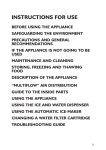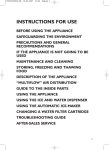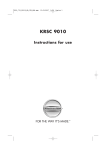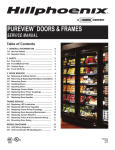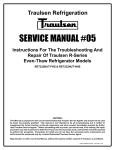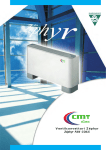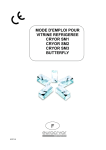Download Whirlpool 25RI-D4 PT Troubleshooting guide
Transcript
INSTRUCTIONS FOR USE Page BEFORE USING THE APPLIANCE 5 SAFEGUARDING THE ENVIRONMENT 5 PRECAUTIONS AND GENERAL RECOMMENDATIONS 6 IF THE APPLIANCE IS NOT GOING TO BE USED 7 MAINTENANCE AND CLEANING 7 GUIDE TO THE INSIDE PARTS 8 USING THE ICE AND WATER DISPENSER USING THE AUTOMATIC ICE-MAKER (if available) (if available) 9 9 STORING, FREEZING AND THAWING FOOD 10 “MULTIFLOW” AIR DISTRIBUTION 10 (if available) TROUBLESHOOTING GUIDE 10 CHANGING A WATER FILTER CARTRIDGE (if available) 12 AFTER-SALES SERVICE 12 ELECTRICAL CONNECTION FOR GREAT BRITAIN AND IRELAND ONLY 13 4 Downloaded from Fridge-Manual.com Manuals BEFORE USING THE APPLIANCE • Your new appliance is designed exclusively for domestic use. To ensure best use of your appliance, carefully read the operating instructions which contain a description of the product and useful advice. Keep these instructions for future reference. 1. After unpacking the appliance, make sure it is not damaged and that the door closes properly. Any damage must be reported to the dealer within 24 hours of delivery of the appliance. 2. Wait at least two hours before switching the appliance on, to ensure that the refrigerant circuit is fully efficient. 3. Installation and the electrical connection must be carried out by a qualified technician according to the manufacturer’s instructions and in compliance with the local safety regulations. 4. Clean the inside of the appliance before using it. SAFEGUARDING THE ENVIRONMENT 1. Packing The packing material is 100% recyclable and bears the recycling symbol. For disposal, comply with the local regulations. Keep the packing materials (plastic bags, polystyrene parts, etc.) out of the reach of children, as they are a potential source of danger. 2. Scrapping/Disposal The appliance is manufactured using recyclable material. This appliance is marked in compliance with European Directive 2002/96/EC on Waste Electrical and Electronic Equipment (WEEE). By ensuring the correct disposal of this appliance, you can help prevent potentially negative consequences for the environment and the health of persons. The symbol on the appliance, or on the accompanying documents, indicates that this appliance should not be treated as domestic waste but must be taken to a special collection centre for the recycling of electrical and electronic equipment. When scrapping the appliance, make it unusable by cutting off the power cable and removing the doors and shelves so that children cannot easily climb inside and become trapped. Scrap the appliance in compliance with local regulations on waste disposal, taking it to a special collection centre; do not leave the appliance unattended even for a few days, since it is a potential source of danger for children. For further information on the treatment, recovery and recycling of this product, contact your competent local office, the household waste collection service or the shop where you purchased the appliance. Downloaded from Fridge-Manual.com Manuals Information: This appliance does not contain CFCs. The refrigerant circuit contains R134a (HFC) or R600a (HC) (see the rating plate inside the appliance). Appliances with Isobutane (R600a): isobutane is a natural gas without environmental impact, but is flammable. Therefore, make sure the refrigerant circuit pipes are not damaged. This product may contain Fluorinated Greenhouse Gases covered by the Kyoto Protocol; the refrigerant gas is inside a hermetically sealed system. Refrigerant gas: R134a has a Global Warming Potential of (GWP) 1300. Declaration of conformity • This appliance has been designed for preserving food and is manufactured in compliance with Regulation (CE) No. 1935/2004. • This appliance has been designed, manufactured and marketed in compliance with: - safety objectives of the “Low Voltage” Directive 2006/95/CE (which replaces 73/23/CEE and subsequent amendments); - the protection requirements of Directive “EMC” 89/336/EEC amended by Directive 93/68/EEC. Electrical safety of the appliance can only be guaranteed if it is correctly connected to an approved earthing system. 5 PRECAUTIONS AND GENERAL RECOMMENDATIONS INSTALLATION SAFETY • The appliance must be handled and installed by two or more persons. • Be careful not to damage the floors (e.g. parquet) when moving the appliance. • During installation, make sure the appliance does not damage the power cable. • Make sure the appliance is not near a heat source. • To guarantee adequate ventilation, leave a space on both sides and above the appliance and follow the installation instructions. • Keep the appliance ventilation openings free. • Do not damage the appliance refrigerant circuit pipes. • Install and level the appliance on a floor strong enough to take its weight and in a place suitable for its size and use. • Install the appliance in a dry and well-ventilated place. The appliance is arranged for operation in places where the temperature comes within the following ranges, according to the climatic class given on the rating plate. The appliance may not work properly if it is left for a long time at a temperature outside the specified range. • Do not store or use petrol, flammable liquids or gas in the vicinity of this or other electrical appliances. The fumes can cause fires or explosions. • Do not use mechanical, electric or chemical means other than those recommended by the Manufacturer to speed up the defrost process. • Do not use or place electrical devices inside the appliance compartments if they are not of the type expressly authorised by the Manufacturer. • This appliance is not intended for use by persons (including children) with reduced physical, sensory or mental capabilities, or lack of experience and knowledge, unless they have been given supervision or instruction concerning use of the appliance by a person responsible for their safety. • To avoid the risk of children becoming trapped and suffocating, do not allow them to play or hide inside the appliance. • Do not swallow the contents (non-toxic) of the ice packs (in some models). • Do not eat ice cubes or ice lollies immediately after taking them out of the freezer since they may cause cold burns. Climatic Class Amb. T. (°C) Amb. T. (°F) SN From 10 to 32 From 50 to 90 N From 16 to 32 From 61 to 90 ST From 16 to 38 From 61 to 100 T From 16 to 43 From 61 to 110 • Make sure the voltage specified on the rating plate corresponds to that of your home. • Do not use single/multi adapters or extension cords. • For the water connection, use the pipe supplied with the new appliance; do not reuse that of the previous appliance. • Power cable modification or replacement must only be carried out by qualified personnel. • It must be possible to disconnect the appliance from the power supply by unplugging it or by means of a mains two-pole switch installed upstream of the socket. 6 Downloaded from Fridge-Manual.com Manuals USE • Before carrying out any maintenance or cleaning operation, unplug the appliance or disconnect it from the power supply. • All appliances equipped with an automatic icemaker and water dispenser must be connected to a water supply that only delivers drinking water (with mains water pressure of between 0.17 and 0.81 Mpa (1.7 and 8.1 bar)). Automatic ice-makers and/or water dispensers not directly connected to the water supply must be filled with drinking water only. • Use the refrigerator compartment only for storing fresh food and the freezer compartment only for storing frozen food, freezing fresh food and making ice cubes. • Do not store glass containers with liquids in the freezer since they may burst. The Manufacturer declines any liability if the above advice and precautions are not respected. IF THE APPLIANCE IS NOT GOING TO BE USED - Disconnect the appliance from the power supply. - Remove all the food and leave the doors open enough for air to circulate inside the compartments. This will prevent the formation of mould and bad odours. - If the appliance has an automatic ice-maker: 1. Shut off the water supply to the appliance. 2. Empty the ice bucket. Power failure In case of power failures of up to 24 hours, keep the doors of the appliance closed. In this way the stored food will stay cold as long as possible. In case of power cut exceeding 24 hours, remove the food from the appliance and store in another suitable appliance. MAINTENANCE AND CLEANING Periodically clean the appliance with a cloth and a solution of lukewarm water and neutral detergent specific for refrigerator interiors. Never use detergents or abrasives. • Do not use steam cleaners. • Clean the condenser using a vacuum cleaner, remove the front kickplate (see installation handbook). • The buttons and control panel display (located on the freezer door on some models) must be cleaned with a dry cloth; do not use alcohol or alcohol-derived substances. • The refrigerant system pipes are located near the defrost pan and can become very hot. Periodically clean them with a vacuum cleaner. Replacing light bulbs Attention • Always disconnect the refrigerator from the power supply before replacing any light bulbs. • Before replacing the light bulb, remove the light guard that may be present. This will have to be put back after replacing the light bulb. • The refrigerator accepts light bulbs with a bayonet type mount. • The ice/water dispenser light bulb has a standard screw type mount. Replace the lamp with one of the same type, available from the Aftersales Service or from authorised dealers. Downloaded from Fridge-Manual.com Manuals 7 GUIDE TO THE INSIDE PARTS FRESH FOOD COMPARTMENT (if available) The fresh food compartment has a tilting movement that facilitates the introduction and the removal of food. Opening, removal and replacing of the Fresh Food compartment. Open the Fresh Food compartment by pressing one of the buttons (1), while at the same time pulling the compartment as far as it will go. To close follow the inverse procedure. To remove the Fresh Food compartment proceed as above instructions and then lightly rotate and remove the compartment from it seat (2). To replace the compartment insert the external lateral guides of the container (3a) in their seats near the retaining pins (3b). 3a Note: Do not store any food in metal or sharp packaging inside the fresh food compartment as this could damage the surface of the compartment itself. Removing the crisper or meat drawer: 1. slide the drawer out as far as it goes; 2. with one hand underneath the drawer, lift and pull it out; 3. the drawer will come off the runners and can be pulled out further; 4. to remove it completely, the drawer must be turned: front end up, rear end down. Loading procedure Maximum storage capacity can be obtained by removing the two bottom drawers/baskets from the freezer compartment. Make sure that the air vents are not obstructed by the food (this applies to units with capacity lower than 715 litres). Meat drawer temperature control device • The cold air is conveyed inside the meat drawer through an opening between the refrigerator compartment and the freezer compartment. In this way the temperature inside the meat drawer is kept lower than the rest of the refrigerator. The air flow can be adjusted by means of the special slider. • To store vegetables in the meat drawer, shift the control device all the way to the left, to the vegetables setting. This avoids possible damage due to the vegetables freezing. Crisper moisture control device • The level of humidity inside the crisper can be adjusted by moving the slider in the desired position. • By moving the slider to the far right, humidity will be eliminated from the compartment. This setting is better for preserving fruits and vegetables with skin. • By moving the slider to the far left, humidity is maintained inside the compartment. This setting is better for preserving leaf vegetables. 8 Downloaded from Fridge-Manual.com Manuals 3b USING THE ICE AND WATER DISPENSER (if available) First use When the ice and water dispenser is used for the first time, the first ice cubes and water coming out of the dispenser may have an unpleasant taste and should therefore be discarded. To dispense water: Water delivery is always available. Press a glass against the water dispenser lever. Water delivery stops when the lever is released. To dispense ice: To obtain ice press against the ice dispenser lever. Press the ICE MODE button to select the desired type of ice (crushed or cubes) Useful tips: 1. Keep the glass near the dispenser outlet. 2. Press lightly on the lever to activate the ice dispenser. Pressing hard will not result in faster dispensing or greater quantities. 3. To stop dispensing, remove the glass slowly so that ice does not fall outside the glass. 4. Do not use fragile glasses. USING THE AUTOMATIC ICE-MAKER (if available) After switching on the refrigerator, it usually takes overnight for the first ice cubes to form. When selecting crushed ice, the cubes are crushed just before being dispensed, therefore the crushed ice may come out with a slight delay. Noise from the ice crusher is normal, and pieces of ice may vary in size. When changing from crushed ice to ice cubes, a small amount of crushed ice may come out together with the first cubes. The quantity and size of the ice cubes depend on the mains water pressure. Ice cubes production can be increased by decreasing the temperature on the freezer compartment. ONLY FOR MODELS FITTED WITH ICE DRAWER Normal ice production consists of about 7 to 8 batches of ice cubes in a 24-hour period. Large amounts of ice cubes should be taken directly from the bucket, and not from the dispenser. It is recommended that the drawer is closed after completing the operation. ONLY FOR MODELS FITTED WITH ICE DISPENSER Normal ice production consists of about 12 to 14 batches of ice cubes in a 24-hour period. Recommendations for the use of the automatic ice maker. When the door of the freezer compartment is open, ensure that the small flap, which functions as a sensor to stop the distribution of ice from the automatic ice maker to the ice container located on the inner door is not obstructed. To remove and replace the ice container 1. Insert your fingers in the opening at the bottom of the container and place your thumb on the release button. Holding the base of the container with both hands, press the release button, lift the container upwards and remove. To replace the ice container in its place, place it on its support attached to the inner door and lower in position. Note: Large amounts of ice cubes should be taken directly from the bucket, and not from the dispenser. Downloaded from Fridge-Manual.com Manuals 1 9 STORING, FREEZING AND THAWING FOOD Wrap food so that no water, moisture or condensate can enter; this will prevent odours or aromas going from one part to another in the refrigerator, ensuring better preservation of frozen foods. NOTE: Never place hot food in the freezer. Cooling hot foods before freezing saves energy and prolongs the life of the appliance. “MULTIFLOW” AIR DISTRIBUTION (if available) “MULTIFLOW” is a ventilated air distribution system, which ensures a homogeneous temperature inside the refrigerator compartment. Thanks to this system, the different types of food can be stored on any of the shelves of the appliance. Attention should be paid not to obstruct the air distribution vents, thus ensuring free air circulation. TROUBLESHOOTING GUIDE Before contacting the After-sales Service… Operation problems are often due to minor causes that can be found and fixed without using any tools. Noises from appliances are normal since the fans and compressors for controlling its operation switch on and off automatically. Some noises can be reduced by: levelling the appliance and installing it on a flat surface, separating and preventing contact of the appliance with the cabinets, making sure the inside parts are correctly positioned, making sure the bottles and containers are not touching each other. Some possible operation noises: • hissing when the appliance is switched on the first time or after a long period. • gurgling when the refrigerant enters the pipes. • humming when the water valve or fan are activated. • rattling when the compressor starts up or when the ice drips in the bucket. • a sudden thud when the compressor starts up or stops. The appliance does not work: • Is the power cable plugged into a socket powered with the right voltage? • Have you checked the protection devices and fuses of your home’s electrical system? The motor seems to run too much: • Is the condenser free of dust and fluff? • Are the doors properly closed? • Are the door seals intact? • On hot days or when the room is warm, it is normal for the motor to run longer. • If the appliance door has been left open for a long time or if large amounts of food have been introduced, the motor will run longer in order to cool the inside of the appliance. If moisture has accumulated: • Make sure the air ducts inside the compartment are not blocked and thus preventing the circulation of air. • If the room is very humid, it is normal for moisture to accumulate inside the appliance. 10 Downloaded from Fridge-Manual.com Manuals If there is water in the defrost pan: • This is normal in hot and humid weather. The pan can even be half full. Make sure the refrigerator is level so that water does not spill from the pan. If the appliance temperature is too high: • Are the appliance controls correctly adjusted? • Has a large amount of food been placed in the appliance? • Make sure the air ducts inside the compartment are not blocked and thus preventing the circulation of cold air. If the area in contact with the seal is hot to the touch: • This is normal in hot weather and when the compressor is working. If the doors do not open and close properly: • Make sure the door seals are not dirty or sticky. • Make sure the appliance is level. If the light does not work: • Is the lamp burnt? IF THE APPLIANCE IS FITTED WITH A DISPENSER If the automatic ice-maker does not work: • Has the freezer had enough time to become cold? With a new appliance this may take overnight. • Is the automatic ice-maker ON/OFF button set to ON? (On some models. Refer to the product sheet). • Is water reaching the automatic ice-maker? Is the water cock open? The filter may be clogged or not correctly installed. Firstly, check the filter installation instructions to make sure the filter is correctly fitted and not clogged. If installation or clogging is not the problem, call qualified personnel or a technician. If the dispenser does not work: • Is the freezer compartment door closed? • Is the ice bucket correctly installed? If the ice dispenser stops working: • Are the ice cubes stuck because the ice dispenser has not been used for some time? Shake the ice bucket to separate the cubes and increase the holding capacity. It is advisable to throw away the old ice cubes and make new ice. • Has the ice dispenser lever been pressed for too long? Wait about 3 minutes for the dispenser motor to reset. If the dispenser does not dispense ice when the lever is pressed: • Change the ice selection from cubes to crushed ice, or vice versa, in order to remove any ice blocks. If the dispenser still does not dispense ice, wait a couple of minutes and repeat the operation. If the dispenser does not dispense water when the lever is pressed: • During the first delivery, there will be a delay of 15 to 20 seconds due to the system needing to fill with water. • If the appliance is kept at very cold temperatures and the meat drawer temperature control shutter is open, water delivery might be temporarily interrupted. Closing the shutter will cause water delivery to recommence within the next 12 hours. If there is condensate in the ice and water dispenser: • Press the corresponding button (marked with A in the figure) to activate the anticondensate function. Automatic ice-maker noises: Since the appliance is equipped with an automatic ice-maker, you may hear a humming sound (coming from the water valve), water trickling and the sound of ice falling into the bucket. Downloaded from Fridge-Manual.com Manuals 11 CHANGING A WATER FILTER CARTRIDGE (if available) 1. Locate the water filter cartridge cap below the freezer compartment door. Rotate the cap counterclockwise to a vertical position and pull the cap and filter cartridge out through the base grille. 2. Remove the cartridge cap by sliding it off the end of the old cartridge. DO NOT DISCARD THE CAP. 3. Take the new cartridge out of its packaging and remove the protective cover. 4 Slide the cartridge cap onto the new cartridge as shown. 5. With cartridge cap in the vertical position, push the new filter cartridge into the base grille until it stops. Rotate the cartridge cap clockwise to a horizontal position. 6. RUN WATER THROUGH THE DISPENSER UNTIL THE WATER RUNS CLEAR (about 9-14 litres or 6-7 minutes). This will clean the system and clear air from the lines. Note: as air is cleared from the system, water may spurt out of the dispenser. Ordering replacement filters To order more water filter cartridges, please contact your After-sales Service. 1 2 4 5 3 AFTER-SALES SERVICE Before contacting the After-sales Service: Switch the appliance on again to see if the problem has been solved. If it has not, switch off the appliance again and repeat the operation after one hour. If your appliance still does not work properly after carrying out the checks listed in the troubleshooting guide and switching the appliance on again, contact the After-sales Service, clearly explaining the problem and specifying: • the type of fault, • the model, • the type and serial number of the appliance (given on the rating plate), 12 Downloaded from Fridge-Manual.com Manuals • the Service number (the number after the word SERVICE on the rating plate inside the appliance). Note: If removal of appliance door is carried out by the After-sales Service it is not covered by the warranty. ELECTRICAL CONNECTION FOR GREAT BRITAIN AND IRELAND ONLY Warning - this appliance must be earthed Fuse replacement If the mains lead of this appliance is fitted with a BS 1363A 13amp fused plug, to change a fuse in this type of plug use an A.S.T.A. approved fuse to BS 1362 type and proceed as follows: 1. Remove the fuse cover (A) and fuse (B). 2. Fit replacement 13A fuse into fuse cover. 3. Refit both into plug. Important: The fuse cover must be refitted when changing a fuse and if the fuse cover is lost the plug must not be used until a correct replacement is fitted. Correct replacement are identified by the colour insert or the colour embossed in words on the base of the plug. Replacement fuse covers are available from your local electrical store. For the Republic of Ireland only The information given in respect of Great Britain will frequently apply, but a third type of plug and socket is also used, the 2-pin, side earth type. Socket outlet / plug (valid for both countries) If the fitted plug is not suitable for your socket outlet, please contact After-sales Service for further instruction. Please do not attempt to change plug yourself. This procedure needs to be carried out by a qualified technician in compliance with the manufactures instructions and current standard safety regulations. Downloaded from Fridge-Manual.com Manuals 13










